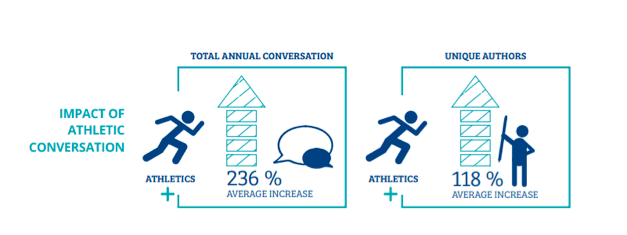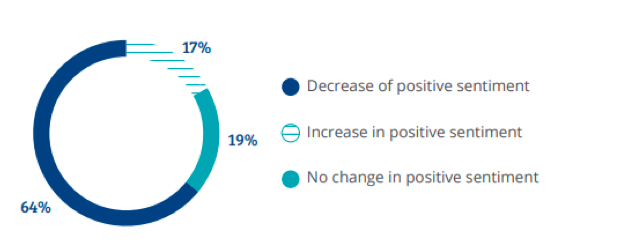You have /5 articles left.
Sign up for a free account or log in.
Late in February, college basketball’s biggest rivalry returned to the biggest stage, with the eighth ranked North Carolina Tar Heels visiting the top ranked Duke Blue Devils.
Always a spectacle, hype for the game reached unprecedented levels. The game drew an A-List crowd, and ticket prices reached heights typically only seen for the Super Bowl. Why the extra attention? Duke freshman phenom Zion Williamson, who had taken the NCAA by storm in his freshman season.
But a mere 30 seconds into his most anticipated game of the season, Williamson was injured. Pivoting to his left, his foot, adorned in newly-released Nikes, slipped, and his foot blew from his shoe as his right knee twisted. Williamson collapsed awkwardly to the court. His night, and for all intents and purposes, the game, were over.
Immediate Social Conversation
Reaction to the injury was swift and severe. Fans pointed much of their anger at Nike, whose stock dropped 1.37 percent in premarket trading the following morning, costing the company almost 3 billion dollars.
But Duke University was not spared. The injury renewed conversation about the NCAA, amateurism, and the balance of power in college athletics. Many fans used the injury to criticize Duke and call out the hypocrisy that in a game featuring record ticket prices and the top paid head coach in college basketball—Duke Head Basketball Coach Mike Krzyzewski earns $8.89 million per year—Williamson, his star player, wouldn’t be compensated.
Impact of Athletics on Total Conversation
If you work on campus, you already know that college athletic programs can generate almost unimaginable reach and brand awareness for colleges and universities. And if you are one of the lucky administrators whose basketball team has qualified for this year’s postseason tournaments, you are undoubtedly hoping to be this year’s UMBC—a Cinderella run can be a boon to website traffic and application volume.
But new research from Campus Sonar shows the effects of athletic conversation can cut both ways.
Certainly, the existence of an athletics program drives conversation volume for schools. In Campus Sonar’s Online Benchmarking study, institutions with an athletics program received more than half of their total online conversation from athletics-related topics, on average. For these schools, athletics increased a school’s total online conversation by 236 percent on average and the number of unique authors for each institution by 118 percent on average. Put simply, people love to talk about college athletics.

 But more conversation does not necessarily equal better conversation, as the Zion Williamson injury demonstrates. Indeed, in the study, 64 percent of institutions with an athletic affiliation saw a decrease in positive sentiment in their overall online conversation when athletics conversations were included.
But more conversation does not necessarily equal better conversation, as the Zion Williamson injury demonstrates. Indeed, in the study, 64 percent of institutions with an athletic affiliation saw a decrease in positive sentiment in their overall online conversation when athletics conversations were included.

Increasing Positive Sentiment Through Athletics
It doesn’t have to be that way. Six institutions in Campus Sonar’s study saw an increase in positive sentiment in their online conversation with the addition of athletics mentions. And while these institutions do not uniformly possess championship programs, there are commonalities in the way that they treat athletics conversation that you can bring to your own campus, regardless of whether your basketball teams will contribute to the madness of March.
First, the schools that experienced an increase in positive sentiment when incorporating athletics conversation make it a priority to cover individual athletes outside of competition, rather than strictly team results. This tactic makes sense, especially for smaller institutions, as an increase in athletics-related positive sentiment is likely tied to a personal investment in an athletics program due to geographic proximity or a personal connection. Beloit College accomplishes this through off-season check-ins with athletes, but you should also consider student-athlete Q&As (especially on Reddit and Instagram) and behind-the-scenes looks at life as a student-athlete.
We’re drawn to sports, and March Madness in particular, due to its unpredictable nature, but that unpredictability can wreak havoc on a brand. When institutions promote athletics reactively, they lose control of the tone of conversation and are left to the whims of their fans, who have been shown to become angry, rather than sad,after a poor result, and increasingly turn to social media to voice those frustrations.
That’s why it crucial to proactively tie your athletics conversations back to your institutional brand, showing the value of athletics beyond the playing field. Hamline University did a great job with this when they shared photos from a recent meeting of their Student Athlete Advisory Committee, which reinforced their brand pillar of a dedicated, accessible faculty.
As you fill out your brackets and ready your popcorn for another year of March Madness, it’s important to remember that athletic programs play an significant role in an institution’s online conversation. But left unmanaged, that conversation can have an unexpected, even damaging effect on total online conversation. That doesn’t have to be the case. As the examples from Beloit College and Hamline University show, there are ways to coach better results online from your athletics staff and student-athletes.
Stephen App is an account executive at Campus Sonar, a specialized social listening agency committed to higher education.








